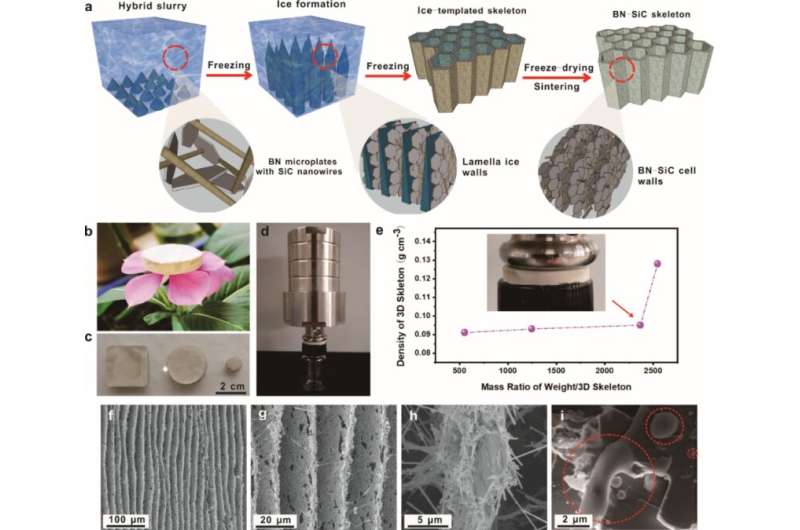Fabrication and characterization of 3-D BN-SiC skeleton. Credit: Dr. YAO Yimin
A research team led by Dr. Sun Rong and Dr. Zeng Xiaoliang from the Shenzhen Institutes of Advanced Technology (SIAT) of the Chinese Academy of Sciences, in collaboration with Prof. Xu Jianbin from the Chinese University of Hong Kong, developed a novel thermal management material, which was light-weight and mechanically tough, and could rapidly transfer heat.
According to the study published in ACS Applied Materials & Interfaces, a 3-D directional skeleton was fabricated via an ice-templated assembly-drying-sintering approach.
High power density in electronics presents an increasing challenge for heat dissipation. High filler content could enhance the thermal conductivity, yet lead to high cost and mechanical properties deterioration inevitably. Thus, it is still a challenge to achieve satisfactory thermal conductivity enhancement with reasonable mechanical properties.
The researchers presented a novel approach to construct an interconnected and aligned boron nitride (BN)-silicon carbide (SiC) hybrid skeleton by the combination of ice-templated assembly and high temperature sintering, and then prepare the 3-D BN-SiC/ polydimethylsiloxane composites.
This ice-templated and sintered BN-SiC skeleton was demonstrated to be an efficient filler to enhance the thermal conducting performance of thermal interface materials.
The welding of SiC nanowires transformed the frail BN sponge into a 3-D continuous skeleton via thin interfacial borosilicate glasses phases, which enhanced the transfer of phonons between the adjacent BN plates and reduced the inter-skeleton phonon scattering.
"The sintering process could further facilitate the interfacial thermal transport," said Dr. Sun Rong. "Combined with ice-templated assembly technology, we offer an efficient strategy to achieve a remarkable improvement of for heat dissipation capacity in electronics."
This study represents a new avenue to addressing the heat challenges in traditional electronic products.
More information: Yimin Yao et al. Achieving Significant Thermal Conductivity Enhancement via an Ice-Templated and Sintered BN-SiC Skeleton, ACS Applied Materials & Interfaces (2019). DOI: 10.1021/acsami.9b19280
Journal information: ACS Applied Materials and Interfaces
Provided by Chinese Academy of Sciences























